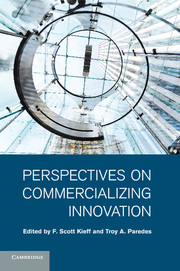Book contents
- Frontmatter
- Contents
- Contributors
- Dedication
- Acknowledgments
- Introduction
- Part I Perspectives on Theories of Intellectual Property
- 1 Intellectual Property and the Theory of the Firm
- 2 A Transactional View of Property Rights
- 3 The Modularity of Patent Law
- 4 Forging a New Environmental and Resource Economics Paradigm
- 5 Privatizing the Public Domain
- Part II Perspectives on the Problems of Anticommons and Patent Thickets
- Part III Perspectives on Finance and Commercialization
- Part IV Perspectives on the University Innovation
- Part V Perspectives on International Considerations
- Index
- References
1 - Intellectual Property and the Theory of the Firm
from Part I - Perspectives on Theories of Intellectual Property
Published online by Cambridge University Press: 05 December 2011
- Frontmatter
- Contents
- Contributors
- Dedication
- Acknowledgments
- Introduction
- Part I Perspectives on Theories of Intellectual Property
- 1 Intellectual Property and the Theory of the Firm
- 2 A Transactional View of Property Rights
- 3 The Modularity of Patent Law
- 4 Forging a New Environmental and Resource Economics Paradigm
- 5 Privatizing the Public Domain
- Part II Perspectives on the Problems of Anticommons and Patent Thickets
- Part III Perspectives on Finance and Commercialization
- Part IV Perspectives on the University Innovation
- Part V Perspectives on International Considerations
- Index
- References
Summary
Introduction
Intellectual property (IP) rules are fundamental to economic activity because they affect transaction costs in the market for ideas. Just as transaction costs affect the allocation of goods and services, so transaction costs affect the allocation of ideas. Transaction costs in the market for ideas include the full range of such costs: communication and information processing, search and matching, bargaining, moral hazard, adverse selection, free riding, and contracting. These transaction costs occur in direct exchange among individuals as well as in intermediated exchange through firms. The market for ideas includes the exchange of basic scientific and technological discoveries, new product designs, manufacturing processes, and business methods. Ideas that are subject to market exchange can be embodied in goods and services, including final products, production equipment, software, and consulting services. Alternatively, ideas can be exchanged in disembodied forms, including blueprints, designs, formulas, and other technical descriptions.
This discussion identifies three critical areas in which the system of IP rights affects the economy. First, IP rights influence the establishment of firms because they affect the relative transaction costs of direct and intermediated exchange in the market for ideas. Individuals establish firms when the transaction costs of intermediated exchange are less than the transaction costs of direct exchange. IP rules will affect the relative costs of direct exchange and intermediated exchange in markets for ideas. Therefore, IP rights affect the scope of the firm, that is, the mix between its market-making activities and its organizational activities. However, IP rights also affect the establishment of firms themselves and the economic mix between direct exchange and intermediated exchange. IP rules are inefficient if they induce an inefficient mix of direct exchange and intermediated exchange in the market for ideas. Property rights are important for developing the market for innovations. With well-defined IP rights, firms are able to serve as intermediaries in the market for IP, whether though internal transactions or through external market transactions.
- Type
- Chapter
- Information
- Perspectives on Commercializing Innovation , pp. 9 - 46Publisher: Cambridge University PressPrint publication year: 2011
References
- 1
- Cited by



